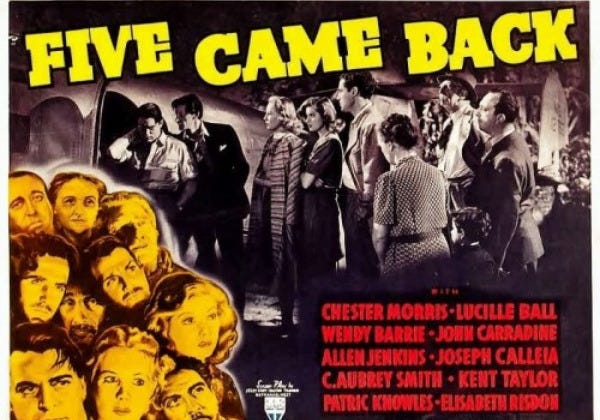Five Came Back (1939)

When it came out in 1939, "Five Came Back" was seen as a low-budget adventure flick about a group whose plane crash-lands in the Amazonian jungle. It was just another B movie from RKO, a studio famous for churning them out.
But in many ways, the film can be seen as a precursor to the modern disaster flicks that had their heyday in the 1970s, and then another one in the '90s.
The main hallmark of the genre is there: A large, disparate cast of people from different walks of life who are brought together by their dire fate. Some of them grow closer, some ennoble themselves through their struggle, while others are tested and found wanting.
There's no big-budget spectacle, but director John Farrow does what he can with a lot of model airplanes and shaking sets. One scene that is fairly horrifying is when the plane steward is sucked out the door.
I was fairly amused by the accommodations on the plane. Despite being a tiny craft, each passenger has their own mini-compartment complete with a fold-out bed and privacy curtain. Lately some high-end airlines have introduced private cubicles, at an extraordinary premium, to lure elite travelers. Back in 1939, this was considered standard seating arrangements.
One has to wonder about the expectations audiences had for a movie titled "Five Came Back." Since a dozen people were on the plane when it took off, we can figure out on our own that more than half the passengers and crew will buy it.
The big dilemma, and the movie's hook -- Dalton Trumbo was among a quartet of writers -- comes when they repair the plane and make to take off before the tribe of local cannibals arrive. The pilot informs them that the plane can only take the weight of five people. (Some math whiz, that pilot.)
Still, it'd be interesting to see other films try to get away with the same trick for their titles. Imagine if "The Bridge on the River Kwai" was instead called "The Bridge is Blown Up, the Train Crashes and Most Everybody Dies."
"Five Came Back" features a few recognizable actors. There's a young Lucille Ball as Peggy, a woman of ill repute. John Carradine, the beanpole character actor, plays Mr. Crimp, a detective hired to transport an anarchist back to Panama City for trial and hanging. Mr. Crimp's not a particularly attentive guard: The prisoner, Vasquez (Joseph Calleia), steals his gun and nearly escapes before he's even turned over to his charge.
There's a rich young man eloping with his secretary, who catches the eye of Joe, the co-pilot. We also have an elderly professor (C. Aubrey Smith) and his fussbudget wife, a mob tough guarding the son of his boss, and Bill (Chester Morris), the stiff-necked but no-nonsense captain.
Most of the gang holds it together pretty well as the weeks go by. It's notable that the lawman, Crimp, is depicted as the most selfish character, while the two criminals, Vasquez and the mafia triggerman, sacrifice themselves for the common good. The old professor rediscovers romance with his wife, and the secretary learns her rich fiance isn't such a catch after all.
A couple of the men are seen with five o'clock shadow now and then, but it's almost laughable how everyone's hair and clothes remain neat as a button despite living in the jungle -- they must've had a large stash of Brylcreem onboard. And I got quite a chuckle out of the women traipsing around the bush in their high heels.
"Five Came Back" was remade a couple of times in the 1950s, but the film it most reminded me of was 1965's "Flight of the Phoenix," about a group of soldiers who crash in the desert and have to scavenge together a makeshift plane out of the wreckage of their old one.
Again, the mark of the disaster flick is not the particular circumstances, but the motley collection of characters each affected by the disaster in their own way. "Five Came Back" may have been a low-budget quickie, but it set the pattern for decades of movies to come.
4 Yaps



